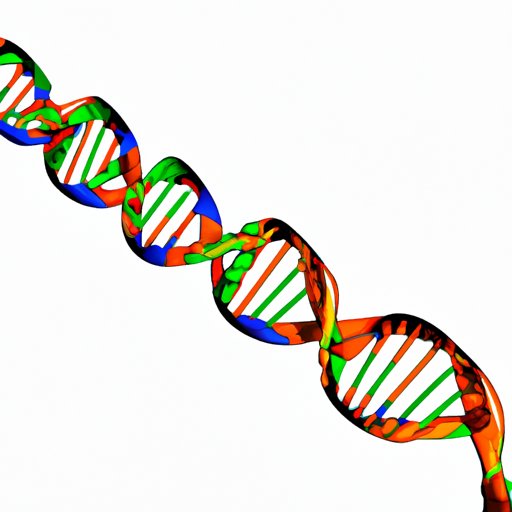Introduction
Understanding the fundamental processes of protein synthesis is essential to grasping the complexity of life, and its language is nucleic acids. Scientists quickly identified DNA and RNA for their crucial roles in the transfer of genetic information, yet determining which nucleic acid holds the master code for protein synthesis remained a mystery. This article aims to unravel the secrets of protein synthesis and explore the pivotal role of nucleic acids in this process.
Unveiling the Key Player in Protein Synthesis: The Role of DNA in Genetic Code Transmission
The first step to understanding protein synthesis is to recognize the importance of DNA. DNA acts as a blueprint or a template for carrying genetic information. It is a double-stranded nucleic acid consisting of a sugar-phosphate backbone and nitrogenous bases that code for the body’s traits and characteristics.
The process of DNA replication ensures that the genetic information is accurately transferred from parent cells to daughter cells. The DNA molecule unzips to expose its nitrogenous bases, which serve as a template for the synthesis of a new complementary molecule. This reliable replication process is vital to ensure proper protein synthesis and body function.
From DNA Replication to Protein Synthesis: Uncovering the Secrets of mRNA as the Key Molecular Messenger
While DNA holds the genetic code, it doesn’t directly participate in protein synthesis. That role is reserved for RNA, a single-stranded molecule whose primary role is to gather and transfer genetic information between DNA and ribosomes—the site of protein synthesis in cells.
Messenger RNA (mRNA) is a type of RNA that carries the genetic information from DNA to ribosomes. The synthesis of mRNA, called transcription, occurs in the cell nucleus, where the DNA unwinds to expose its nitrogenous bases. An enzyme then reads the DNA code and synthesizes a complementary mRNA molecule. The newly synthesized mRNA then leaves the nucleus and travels to ribosomes located in the cytoplasm.
Protein Synthesis: The Crucial Role of Nucleic Acids in the Language of Life
Protein synthesis is the process by which amino acids are linked together to form proteins. It is an intricate process that involves the coordination of multiple nucleic acid molecules. There are three main types of RNA involved: mRNA, transfer RNA (tRNA), and ribosomal RNA (rRNA).
As mentioned earlier, mRNA carries the genetic code to ribosomes. tRNA plays a crucial role in protein synthesis by decoding the mRNA sequence and supplying the amino acids required to form the protein. rRNA forms the ribosome’s structural components and helps catalyze the formation of peptide bonds between amino acids.
The Central Dogma of Biology: How DNA Provides the Ultimate Blueprint for Protein Production
The central dogma of biology describes how DNA, RNA, and proteins interact in cells to carry out genetic information. The flow of genetic information in cells starts from DNA, which encodes the genetic information that determines the specific sequence of amino acids in a protein. This genetic information is then transcribed into mRNA, which carries the code to ribosomes for translation into proteins. Once the protein is synthesized, it folds into a specific three-dimensional shape and carries out its biological function.
tRNA plays a crucial role in bringing the correct amino acids to the ribosome. The correct amino acid is selected by tRNA based on its anticodon sequence, which pairs with the codon on the mRNA molecule. The tRNA then delivers the amino acid to the ribosome for it to be incorporated into the growing protein chain.
Deciphering the Genetic Code: Exploring the Relationship between Nucleic Acids and Protein Synthesis
The genetic code is the language of life, and it is encoded in the sequence of nucleotides in DNA. Each amino acid is specified by a unique three-letter sequence of nucleotides called a codon. There are 64 possible codons, with each codon representing a specific amino acid or stop signal.
During translation, the ribosome reads the mRNA codons and matches each codon to the appropriate amino acid. The correct amino acid is brought to the ribosome by tRNA with an anticodon sequence that matches the mRNA codon. This process continues until a stop codon is reached, signaling the end of protein synthesis.
The importance of the genetic code cannot be overstated. It is the basis for the variation in life and is responsible for the diversity seen in all living organisms.
Conclusion
In conclusion, the mastery of nucleic acid functions is essential for understanding protein synthesis, with RNA taking center stage as mRNA, tRNA, and rRNA coordinate together to produce proteins. DNA provides the genetic code or the ultimate blueprint for protein production, with the nucleic acids representing the language of life. The master of the code is the genetic code, encoded on the sequence of nucleotides in DNA or RNA, which determines all the functional information of the proteins. As such, understanding the central role of nucleic acids in protein synthesis is vital to comprehend the language of life and all of its complexities.
